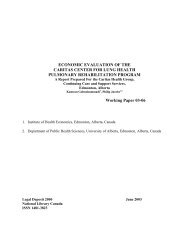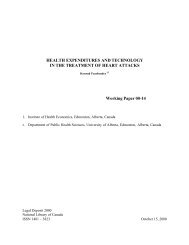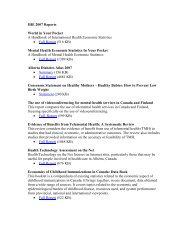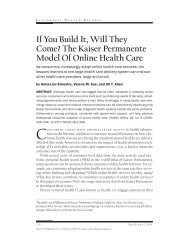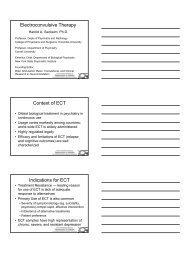Bariatric treatments for adult obesity - Institute of Health Economics
Bariatric treatments for adult obesity - Institute of Health Economics
Bariatric treatments for adult obesity - Institute of Health Economics
- No tags were found...
Create successful ePaper yourself
Turn your PDF publications into a flip-book with our unique Google optimized e-Paper software.
Additional benefits <strong>of</strong> exercise over dietary therapyA negative energy balance can be attained through either eating less, or exercising more or both. 8 Adeficiency <strong>of</strong> 500 kcal per day is recommended to achieve a weight loss rate <strong>of</strong> approximately 0.5kilograms per week. 8 The same energy deficit obtained through either increased exercise or throughdietary restriction may yield similar changes in body weight, but the composition <strong>of</strong> the lost tissuediffers. On average, the composition <strong>of</strong> weight loss is approximately 70% fat and 30% lean bodymass, whereas loss <strong>of</strong> the latter causes a decrease in the resting metabolic rate. 8 Exercise aids inminimizing the loss <strong>of</strong> lean body mass, thereby reducing the decrease in metabolic rate (<strong>for</strong> increasedefficiency) that accompanies any loss in body weight.To obtain the desired energy deficit <strong>for</strong> weight loss under normal circumstances, caloric intake mustbe reduced; it is much easier to reduce caloric intake by 500 kcal per day, <strong>for</strong> example, than toincrease expenditure by that magnitude. Examples <strong>of</strong> activities that use approximately 500 kcal <strong>of</strong>energy, <strong>for</strong> a person weighting approximately 80 kilograms, are an hour <strong>of</strong> jogging at 5 kilometersper hour, or 35 minutes <strong>of</strong> jumping rope. 8In addition to increasing energy expenditure and promoting fat loss, physical exercise has additionalbenefits including:reducing abdominal fat and increasing lean mass;reducing blood pressure and improving glucose tolerance, insulin sensitivity and the lipidpr<strong>of</strong>ile;improving physical fitness;improving compliance to the dietary regimen;improving feelings <strong>of</strong> well-being and self esteem; reducing anxiety and depression. 11Behavioural therapyDefinitionBehavioural therapy, an important component <strong>of</strong> weight management, refers to the principles andtechniques used to change a patient’s behaviour and habits. 5 The goal <strong>of</strong> behavioural therapy is toalter learned eating and activity habits in overweight and obese individuals. 11Although behavioural modification recognizes the role <strong>of</strong> genetics and cultural influences on weight,it focuses on current behaviour, with a particular focus on increasing energy expenditure andreducing energy intake to achieve weight loss. 14 Behavioural therapy provides the individual withcoping skills to handle various cues to overeat and to manage lapses in diet and physical activitywhen they occur. 15 Behavioural therapy also provides the motivation essential to maintainingadherence to a healthier lifestyle over a long period <strong>of</strong> time. 15TypesKey features <strong>of</strong> typical behavioural therapy include self-monitoring, goal setting, nutrition, exercise,stimulus control, problem solving, social support, cognitive restructuring, and relapse prevention(see Table T.2). 5,13,14Brief history and development<strong>Bariatric</strong> <strong>treatments</strong> <strong>for</strong> <strong>adult</strong> <strong>obesity</strong> 66



